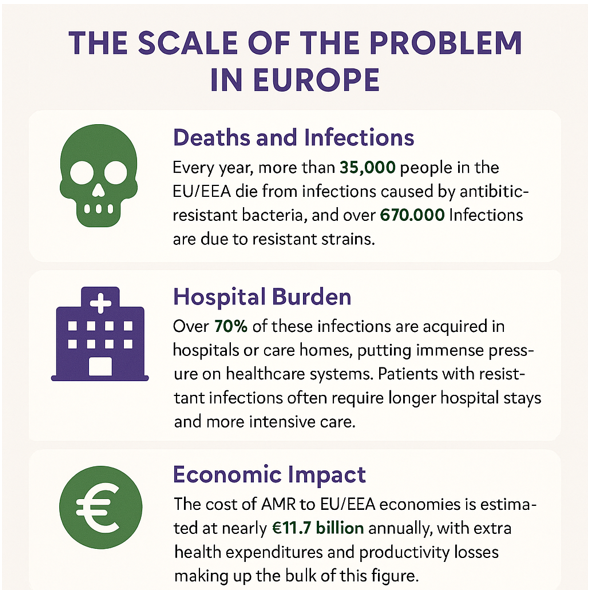Antimicrobial resistance, or AMR, is often called a “silent pandemic” because it is happening quietly all around us. It occurs when bacteria learn how to survive the medicines that once killed them. This is a big deal—it threatens to undo nearly a century of medical progress, starting with Alexander Fleming’s discovery of penicillin back in 1928. If we do not act quickly and work together, we could face a future where antibiotics no longer work, and simple infections or minor cuts could once again become life-threatening.
📊 In 2019, almost 1 in 5 bacterial infections across EU and EEA countries were resistant to antibiotics, though the rates varied a lot from country to country. What is especially concerning is that resistance is rising in some of the most common and dangerous bacteria, like Klebsiella pneumoniae, Escherichia coli (E. coli), and Pseudomonas aeruginosa. At the SSBB consortium, we have been focusing our efforts on finding new ways to fight back against E. coli and Pseudomonas aeruginosa, working hard to stay one step ahead of these tough bacteria.
🤝 To tackle the AMR challenge, experts recommend a “One Health” approach, which means working together across human health, animal health, and the environment. Organizations like the European Commission and the World Health Organization (WHO) are leading efforts to coordinate these actions. Tracking how resistance spreads is also crucial, and agencies such as the European Centre for Disease Prevention and Control monitor trends to help shape policies. Hospitals are stepping up infection prevention efforts to stop resistant bacteria from spreading, and doctors are being encouraged to use antibiotics only when truly necessary.
💭🔮 Looking ahead, research and innovation are vital. We need new antibiotics and alternative treatments to stay ahead of resistant bacteria. This includes developing new types of medicines and finding ways to block bacteria from becoming resistant in the first place. By using antibiotics wisely, improving infection control, and investing in new solutions, we can help protect the effectiveness of these life-saving drugs for everyone.
This blog was written by Larissa Bomfim, one of the PhD candidates working in the SSBB consortium. Larissa is pursuing his PhD trajectory at Erasmus MC University Medical Center Rotterdam in the Netherlands, TissueGnostics in Austria.


